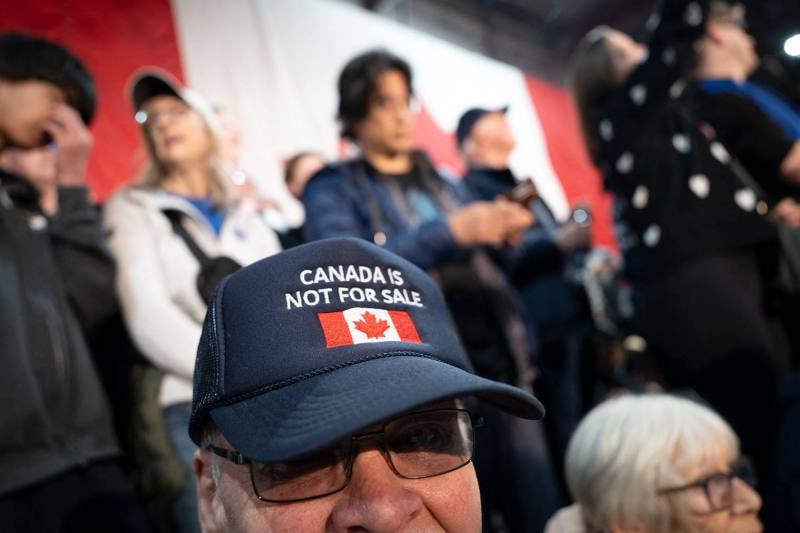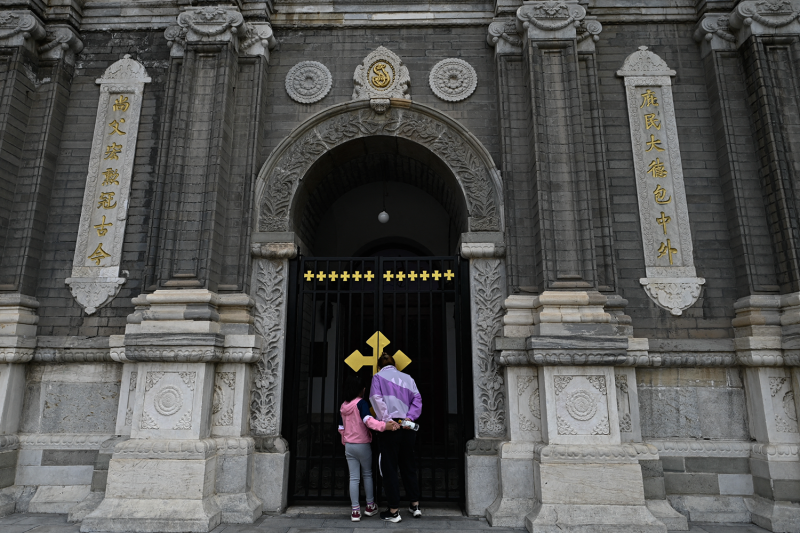Trump’s First 100 Days Reveal a ‘Strongman’s’ Unprecedented Weakness

Trump’s First 100 Days Reveal a ‘Strongman’s’ Unprecedented Weakness
No U.S. president has ever surrendered global power so quickly.
U.S. President Donald Trump speaks to reporters before boarding Air Force One at Morristown Municipal Airport in Morristown, New Jersey, on April 27. Mandel Ngan/AFP via Getty Images
“Nobody has ever seen anything like it,” U.S. President Donald Trump is fond of saying about his supercharged agenda of upending the U.S. government and intimidating his political enemies at home.
He may be right. But when it comes to the world stage, it’s also true that nobody has ever seen such an unprecedented display of weakness from a would-be strongman—and in just 100 days.
“Nobody has ever seen anything like it,” U.S. President Donald Trump is fond of saying about his supercharged agenda of upending the U.S. government and intimidating his political enemies at home.
He may be right. But when it comes to the world stage, it’s also true that nobody has ever seen such an unprecedented display of weakness from a would-be strongman—and in just 100 days.
Whether the issue is national security or economics, in a short period of time, Trump has gone a long way toward unilaterally surrendering the United States’ dominant power and influence around the world—especially in Europe and the Indo-Pacific. The best evidence of this, perhaps, is the combined downward drift of stocks, bonds, and dollar value—something that rarely occurs—suggesting a broad retreat of investment from the United States.
This is precisely the opposite of what Trump promised: a new “golden age of America,” as he said in his inaugural address, in which investment would pour in and “our country will flourish and be respected again all over the world.”
Instead, largely because of an array of Trumpian policies, the United States is being slowly downgraded in investors’ eyes from the ultimate safe haven to an unpredictable wilderness where the rule of law is in doubt.
“A sharp rise in U.S. policy uncertainty has shaken investor confidence in U.S. assets and even sparked debate about the U.S. dollar’s role as the world’s primary reserve currency,” as analysts at J.P. Morgan put it in a recent assessment that was titled, “Is this the downfall of the U.S. dollar?”
Even some of Trump’s strongest business supporters—such as Ken Griffin, the chief executive of the Citadel hedge fund—are warning of permanent damage to the U.S. “brand” thanks to what Griffin called Trump’s “nonsensical” trade war, saying that it could take “a lifetime to repair the damage that has been done.”
By slashing investments in science and education, deporting immigrants indiscriminately, and terrorizing major universities into adopting his right-wing version of political correctness, Trump is also precipitating a kind of brain drain never before imaginable. Not to mention threatening to debilitate the very manufacturing capability that Trump says he wants to restore.
The United States, after all, is a country that has often bested its adversaries—especially the Soviet Union and Nazi Germany—by drawing the best minds to its shores. And that’s setting aside what Trump has done to the domestic rule of law, making it less likely that brainy, talented foreigners will come to a land where anyone can be arrested or deported without due process, domestic terrorists are pardoned en masse, and convicted felons are awarded high government posts (among them trade advisor Peter Navarro and Charles Kushner, nominated as ambassador to France).
All this is happening with the muted approval of the political party that Trump has bullied into silence, the Republican Party, and the largely incoherent demurrals of opposition Democrats who can’t figure out what they stand for. The courts have spoken up against many of his policies, often compellingly, but Trump barely listens to them.
For the president, the only thing that seems to matter is the markets—which now may be the only hope of altering his course.
The nation’s two main rivals, Russia and China, could not be more delighted with Washington’s efforts at wholesale self-destruction as a superpower.
In addressing Russia and its invasion of Ukraine—the issue that he once boasted he’d resolve in a day—Trump has pursued a policy of abject appeasement of Russian President Vladimir Putin. Bizarrely, Trump has combined his obsequious treatment of Putin—who commands an economy one-thirteenth the size of that of the United States—with a repudiation of the very European allies that have, until now, helped Washington restrain Russia.
Thus, the U.S. president is making it more likely that it is he, Trump, who “has no cards to play” at the bargaining table, as he likes to say of Volodymyr Zelensky, the stalwart Ukrainian president.
Trump supporters have said that his eager outreach to Putin and efforts at normalization with Russia amount to savvy realpolitik that, in the manner of a Henry Kissinger, will wean Moscow from its alliance with China. The Trump administration is largely staffed by so-called realists and “restrainers” who are calling for a return to great-power realpolitik—and who criticize Trump’s predecessor, President Joe Biden, for closing himself off to negotiation with Moscow by effectively delegating U.S. strategic policy with Russia to Zelensky.
There is something to this criticism. But by preemptively recognizing Putin’s claim to Crimea and other Ukrainian territory—without extracting any concessions from Russia—Trump looks unmistakably weak. He is also effectively justifying future military land grabs and shredding what remains of the postwar system of territorial norms based on international law. Such future incursions could include a Chinese takeover of Taiwan as well as the realization of Trump’s own covetous ambitions toward Greenland.
In recent days, Trump has acknowledged that the Russian leader may be playing him for a fool, and he’s resorted to pleading with Putin to stop his murderous attacks on Ukrainian cities.
“[T]here was no reason for Putin to be shooting missiles into civilian areas, cities and towns, over the last few days,” Trump wrote in a post on Truth Social on April 26. “It makes me think that maybe he doesn’t want to stop the war, he’s just tapping me along, and has to be dealt with differently, through ‘Banking’ or ‘Secondary Sanctions?’”
And what of China? Beijing is openly mocking Trump’s policies, which have amounted to little more than bluster followed by confusion and retreat. The shock and horror expressed by the markets at Trump’s minimum 145 percent tariffs on China—including a meeting that Trump had with major U.S. retailers who warned of empty shelves and soaring prices—prompted him to reverse course and say he’s now negotiating with China to “substantially” pare back the tariffs.
But Beijing responded with a humiliating denial that any such talks are happening. China also doubled down by banning the export of many rare-earth metals to the United States, sending panic through major industries that can’t run assembly lines without them, including defense contractors who depend on these minerals to make drones and battery-powered vehicles.
William Wohlforth, an international relations expert at Dartmouth College, said that all this amounts to a bumbling effort by Trump and his team to pursue a “gut and grab” strategy—that is, to gut the U.S.-led global order that has prevailed since World War II and grab a larger slice of territorial pie for itself, along the lines of 19th-century presidents such as Trump’s hero, William McKinley.
The problem, Wohlforth said, is that the Trumpers don’t seem to know what they’re doing.
“The preemptive concessions to Russia—indeed, the whole approach of all carrots for Russia, all sticks for Ukraine and the Europeans—is a bad bargaining strategy,” Wohlforth said in an email. “And it really does look like Trump blinked in the game of chicken regarding tariffs with China.”
And now China—which hitherto had few allies—is seizing the moment by trying to portray itself as the stable new center of the global system. As Chinese President Xi Jinping told senior American, Japanese, and Korean business leaders in late March, China is “an ideal, safe and promising investment” alternative. This comes after decades in which U.S. presidents (including Trump in his first term) sought to pressure China to open up and drop its unfair trade practices.
Until Trump took office, China and Russia were two countries practically begging for allies. Moscow had the unquestioned allegiance only of insignificant Belarus—and more recently has partnered with two isolated and heavily sanctioned nations, Iran and North Korea. China could also boast mainly of its ties to North Korea, even as it sought to badger smaller countries into fealty with its Belt and Road Initiative and other debt encumbrances.
Moscow and Beijing then formed a partnership with each other, and together, they have made desultory efforts to expand the BRICS forum of five major emerging economies (originally comprising Brazil, Russia, India, China, and South Africa) as a counterweight to the West. But few are eager to join; several of the new BRICS inductees and invitees—Saudi Arabia, the United Arab Emirates, and Egypt—are still close U.S. security partners, and another, Argentina, later decided not to join.
Meanwhile, until Trump came along, the United States enjoyed more than 50 allies and strategic partners around the world, including most of the richest nations in the world. Now, key allies from Germany to South Korea are looking to develop their own defenses apart from Washington—which would mark a huge hit to the U.S. defense industry and threatens a new dangerous era of nuclear proliferation—in the face of Trump’s constant threats of withdrawal and demands for imperial tribute.
Trump’s familiar complaint is that U.S. allies do nothing but “rip us off.” And to give him some credit, he has pressed NATO allies and Taiwan to put up proposals to spend more for their own defense. But for the most part, Washington has a pretty good deal in the Indo-Pacific and Middle East, considering the share of costs at U.S. bases that is picked up by host countries such as Japan (75 percent), Kuwait (58 percent), Qatar (61 percent), and Saudi Arabia (65 percent), according to a 2013 Rand Corp. report.
The larger issue is that such policies maintain global U.S. leadership and economic dominance.
“Trump might think about this order in his own terms, as real estate: The American order embodies an investment, made over seven decades, that generated incredible returns,” Princeton University scholar John Ikenberry, an expert on the postwar global order, told me during Trump’s first term as the president launched his first fitful assault on the U.S.-led international system. “To destroy this order—undermining the trade regime, the alliances, the institutions, the trust—is like tearing down your most profitable hotel property.”
Indeed, it is difficult to point to any historical precedent for what Trump is doing, Ikenberry says now. “Why would the United States destroy its own hegemonic order? Why would the most powerful state in the global system actively work to make itself weaker, poorer, and less secure?” he writes in a forthcoming paper. “We know that great powers rise and fall; global eras end, and new ones begin. But when have we seen an international order destroyed in this way, by its own creator? Across history, great powers have tended to end—or die—by murder, not suicide.”
When it comes to the hitherto unstoppable U.S. economy, Trump has adopted a set of policies so self-destructive that—to again adapt that familiar Trump trope—nobody’s ever seen anything like it before. Together, they have sapped U.S. economic strength in an astonishingly short period of time.
Just 100 days, in fact. According to a CNBC survey published in early April, a majority of CEOs (69 percent) now expect a recession.
The downward spiral began with Trump’s renunciation of U.S. aid programs and rebuke of allies. But the trend swiftly gathered momentum in early April, after Trump revealed his addled concept of tariffs and trade war.
Once again, there was reason to believe that tough trade pressure on some nations could restore some of the U.S. manufacturing that previous administrations had let slip away to China, Southeast Asia, and other regions.
But Trump imposed tariffs on some 90 countries with no obvious plan other than to collect revenue. And it soon became clear that the supposed “tariffs” Trump said were imposed by other nations on the United States were not the actual policies of those governments. Instead, they represented a crude calculation of that country’s goods exports to the United States divided by the U.S. trade deficit with the country. This appeared to be based on Trump’s false, mercantilist idea that trade is a zero-sum game and a nation’s trade deficits are similar to corporate losses.
Markets plummeted as the entire world seemed to realize at once that the most powerful person on the planet did not understand Economics 101. Certainly, the markets realized it.
Trump has backed off further by announcing a 90-day pause on most tariffs while he negotiates new trade deals. But none seem to be forthcoming, and trade experts say that it is a virtual impossibility to negotiate such deals in that little time.
Meanwhile, the exodus from the United States continues. It’s no small matter that the U.S. dollar is threatening to take its biggest hit—having lost nearly 9 percent in value since Jan. 20, Trump’s Inauguration Day—in more than 50 years, dating back to the so-called Nixon shock of the early 1970s. Like Trump’s tariffs, that could drive up inflation.
Like today, that earlier period was a time when a U.S. president, Richard Nixon, risked the nation’s global reputation by halting the conversion of other nations’ dollar reserves into gold—the mainstay of the postwar financial system.
The ultimate irony may be that Trump apparently aspires to be a strongman who supposedly restores the power of the presidency and respect around the world. Yet he seems to have come into office with an enormously inflated sense of his own ability to bully other countries into submission. As he told the Atlantic in a 100-day interview: “I run the country and the world.”
U.S. power, however, is based not only on military and economic dominance, but also a lot of soft-power sway. Trump didn’t seem to get that last part, just as he didn’t seem to understand that by declaring that he intends to take over Greenland and absorb Canada, he would only unite their populations against him.
Before he took office, Trump often said, while talking about the policies of Biden and his other presidential predecessors: “The world is laughing at us.”
It wasn’t true then—at least, not all that often. It is now. Or it may be that much of the world is crying rather than laughing. Consider: By eliminating the U.S. Agency for International Development and many of its programs, the Trump administration may ultimately cause as many innocent deaths in Africa and the developing world as Putin has brought about in Ukraine—and at the cost, once again, of U.S. influence and prestige.
Still, let’s take a step back to note that the 100 days metric for new presidencies has always been a dubious one. It may well be that, having done his worst, Trump will realize some of the damage that he’s inflicted and adjust. New polls show his approval ratings plunging to the lowest level of any incoming president since such surveys were first taken.
Many historians view the first 100 days as mainly a media contrivance designed to create headlines. Presidential historian Richard Neustadt called the metric “a poor guide to what contemporary presidents can plan or hope to do in their first three months,” arguing that it was a standard unique to President Franklin D. Roosevelt and the New Deal because of the desperate nature of the crisis he faced: the Great Depression. (Though “100 days” originally began as description of the period between French leader Napoleon Bonaparte’s escape from Elba to his final downfall, FDR resurrected the concept in July 1933, when he referred to “the crowding events of the hundred days which had been devoted to the starting of the wheels of the New Deal.”)
“At some level, the hundred days is an important notation in the sense that you’re seeing the president’s initial leadership style,” Lara Brown, a political scientist at the George Washington University, told me in 2021 for an assessment of Biden’s first 100 days. “But in terms of actual performance—is this person going to be successful or not—I think it’s tremendously shortsighted. I would argue that for most presidents in the modern era, the first hundred days is the beginning, not the end, of their stories.”
Worse, the 100 days standard only sends a message of dysfunction and unsteadiness to the rest of the world as each new president seeks to make a big splash. This has been especially true in the past few decades since the Cold War consensus unraveled and each president sought to reverse the policies of his predecessor—none more so than Trump and Biden.
On his first day in office, Biden signed at least 50 executive orders, about half of them reversing Trump policies, including his withdrawal from the Paris climate pact, immigration policies, border wall construction, and the travel ban targeting Muslim-majority countries.
“I’m not making new law. I’m eliminating bad policy,” Biden said at the time.
Trump has outdone him, signing more than 100 executive orders since January—many of them reversing Biden policies—and regularly calling Biden “the worst president in U.S. history.”
Trump himself has happily embraced the 100-day metric. It is one that he often cites to describe the remarkable flurry of activity of his second term—what Trump referred to on April 8 as “the most successful 100 days in the history of our country.”
That is a fantasy. Trump will never admit this, but he has shown signs of retreat in recent days. Treasury Secretary Scott Bessent has reassured the world that the tariffs once said to be “permanent” are now very negotiable. After weeks of suggesting that he might put his “unitary theory of the executive” to the ultimate test and destroy the Federal Reserve’s independence—which led to another market plunge—Trump now denies that he planned to fire Fed Chairman Jerome Powell.
That follows the message delivered in the Oval Office on April 21 by the CEOs of Walmart, Target, and Home Depot, who warned Trump of economic devastation to come.
It’s not too late for him to change direction.
This post is part of FP’s ongoing coverage of the Trump administration. Follow along here.
Michael Hirsh is a columnist for Foreign Policy. He is the author of two books: Capital Offense: How Washington’s Wise Men Turned America’s Future Over to Wall Street and At War With Ourselves: Why America Is Squandering Its Chance to Build a Better World. X: @michaelphirsh
More from Foreign Policy
-

An illustration shows a line of large shopping carts facing down a small Donald Trump figure holding two shopping bags. The stars of China’s flag are in the upper left corner. Why Beijing Thinks It Can Beat Trump
China’s elites have a new confidence in their own system.
-

U.S. Army Chief of Staff Randy George speaks to U.S. soldiers at the Hohenfels Training Area in southern Germany on Feb. 6. A Drawdown of U.S. Forces in Europe Is All but Certain
Here’s how the Pentagon can rebalance its approach to the continent without sacrificing U.S. interests.
-

University of California, Los Angeles students, researchers, and demonstrators rally during a “Kill the Cuts” protest against the Trump administration’s funding cuts on research, health, and higher education in Los Angeles on April 8. Why Authoritarians Attack Universities First
A Yale professor and expert on fascism talks about why he’s leaving the United States under Trump.
-

Dwight D. Eisenhower looks over a piece of paper while sitting on a couch as Robert Cutler looks over his shoulder. How Generations of Experts Built U.S. Power
And now Trump is throwing it all away.










Join the Conversation
Commenting on this and other recent articles is just one benefit of a Foreign Policy subscription.
Already a subscriber?
.
Subscribe
Subscribe
View Comments
Join the Conversation
Join the conversation on this and other recent Foreign Policy articles when you subscribe now.
Subscribe
Subscribe
Not your account?
View Comments
Join the Conversation
Please follow our comment guidelines, stay on topic, and be civil, courteous, and respectful of others’ beliefs.
Change your username |
Log out
Change your username:
CANCEL
Confirm your username to get started.
The default username below has been generated using the first name and last initial on your FP subscriber account. Usernames may be updated at any time and must not contain inappropriate or offensive language.